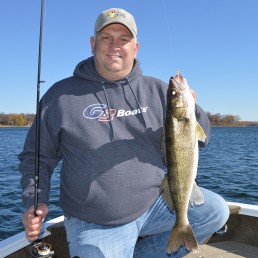Embracing Change Improves Our Fishing
SHARE THIS POST
As we go through life, many of us change the way we do things. We find a better way, or sometimes just a different way of performing some tasks. In the past several decades, many changes have taken place in the fishing world. Here are some of those changes.
In walleye country about 30 years ago, the big deal when it came to boats was an 18-foot aluminum boat and a 50-horsepower motor with tiller steering. This rig provided lots of room and outstanding trolling control. Eventually, some walleye-chasers decided that a boat guided with a steering wheel might be a better idea. Those tiller boats were wonderful to fish from once you got to your spot, and boats with a steering wheel make getting to your spot so much more comfortable and faster. They’re also better if you would want to pull a water skier or tuber.
We’ve seen lots of changes in the “fishin’ poles” available to us. Today’s rods are lighter in weight, more sensitive, and just all-around better for fishing. And some rods are “technique specific.” That means that that particular model of rod was designed for a specific use. Maybe it was designed for flippin’ for bass or trolling for walleyes. Technique Specific rods do a very good job at what they were designed for. However, many of us don’t want, don’t need, or can’t have a rod designed for every technique.
There’s good news for us. Lots of rods available to us are very versatile. I was looking through my rod rack and came upon a Lew’s Speed Stick that I use for live-bait rigging and jigging for walleyes, slip-bobbering for walleyes and crappies, and jig-worming and drop-shotting for bass. It’s a tremendously versatile rod. If a rod for a specific technique is what you want, go for it. But it’s possible to have a single rod that performs a variety of techniques very well.
Fish species popularity has certainly changed. Not that long ago, in a good number of places, walleyes were the most popular fish. Walleyes continue to be favored in those places, but fishing for bass has significantly increased in popularity. Smallmouth bass are abundant in waters where they didn’t used to be common, and anglers have discovered that smallmouth and largemouth bass are willing biters when walleyes are being stubborn.
Are you enjoying this post?
You can be among the first to get the latest info on where to go, what to use and how to use it!
Along with different species becoming more popular, regulations have made it possible for us to catch bigger fish. When muskie fishing started to become popular, a muskie had to be 30 inches long if it was to be kept. There are a good number of waters today where a muskie must be 50 inches if you want to take it home. Some trophy waters, in fact, are catch-and-release only. We’ve learned that if we want to catch big fish, we need to put some smaller fish back.
Lots of other changes are or will be taking place in fishing. The important thing to remember is, that fishing can be whatever we want it to be. Some anglers like to have all the newest and best equipment, while the rest of us like to have nice stuff in adequate quantities. Most of all, we want a place to go fishing where we can enjoy the outdoor experience with another person—or alone. When it comes to fishing, we make it what we want it to be; that’s why going fishing appeals to so many people.
For more fishing insight from the pros who know, check out the next issue of MidWest Outdoors, available by subscribing on our website.
MWO
SHARE THIS POST
You may also like...
Nothing found.
Did you enjoy this post?
You can be among the first to get the latest info on where to go, what to use and how to use it!
Bob Jensen
To see the latest episodes of “Fishing the Midwest” television, new fishing-related tips and articles from the past, visit fishingthemidwest.com. Follow them on Facebook @fishingthemidwest for fishing information and entertainment.
